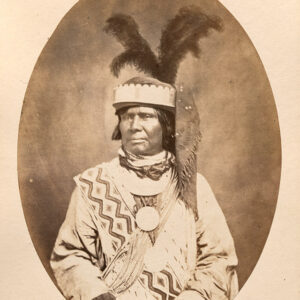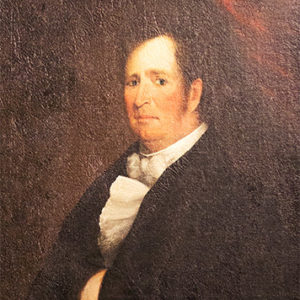calsfoundation@cals.org
Elias Rector (1802–1878)
Elias Rector was appointed U.S. marshal for the Territory of Arkansas later served as superintendent of Indian Affairs. During the Civil War, he sought to make treaties with Native American tribes on behalf of the Confederacy. Rector was the subject of the poem “The Fine Arkansas Gentleman, Close to the Choctaw Line,” written by his friend Albert Pike.
Elias Rector was born on September 28, 1802, in Fauquier County, Virginia. He was the youngest of nine sons born to Wharton Rector and Mary Vance Rector, who was a native of North Carolina. Soon after his birth, the family moved to Illinois, where Elias Rector spent the early part of his youth. The family relocated again, this time to St. Louis, Missouri, where Rector spent most of his childhood. He received the bulk of his education in Lexington and Bardstown, Kentucky, although he seemed to be better suited to the frontier than to formal education.
In 1831, Rector was appointed U.S. marshal by President Andrew Jackson. He served in that post for sixteen years, an unprecedented duration that transcended political divisions and included service under four different presidents. His tenure as U.S. marshal ended in 1846, and he was succeeded by his cousin Henry Massie Rector, who later served as governor of Arkansas. (U.S. Marshal Elias Rector is not to be confused with Henry Massie Rector’s father, who was also named Elias Rector.)
In 1835, Elias Rector married Catherine DuVal, whose brother was Elias Rector DuVal. The couple moved to Fort Smith (Sebastian County) in 1837 and ultimately had eight children.
Rector was a somewhat colorful character, a prosperous planter who was known to charter a boat to take his cotton crop down the river. He wore his hair long, tucked up with a comb under his hat. He was reported to have led an expedition of men from Fort Smith to California in 1850 to search for gold.
As the government undertook efforts to relocate the Native American tribes populating the Southeast, the Southern Superintendency of Indian Affairs was established in 1851 to replace the Western Superintendency. Rector became superintendent of Indian Affairs in 1857, serving until he resigned in 1861 at the beginning of the Civil War. In that position, Rector oversaw the removal of Halpatter-Micco (a.k.a. Billy Bowlegs), known as the “King of the Everglades,” as well as the remaining Seminole who had come to Arkansas following the Seminole Wars in Florida. Upon completion of the task, he was awarded a bonus from Congress for his efficiency. In 1859, as the government effort to push tribes out of the Southeast intensified, Rector founded a new agency in southwestern Indian Territory (present-day Oklahoma). Called the Wichita Agency, it was established near Pond Creek and was the original contact point for the Wichita and Kichai Indians in the area.
Although he was opposed to secession, Rector did not want to take up arms against the South. However, letters written by Rector in the spring of 1861 indicate that he was actively working to gain Indian support for the Confederacy. Rector and Pike (who had been named commissioner of Indian Affairs by the Arkansas state convention) sought to negotiate treaties on behalf of the Confederacy with the Cherokee in the early stages of the war. The effort was abandoned, with Rector then heading to Texas to join his family; they spent four years in Dallas and Austin during the war.
There were are some reports that Rector, who never officially closed the accounts of his office as superintendent of Indian Affairs, used his influence in the prewar days to secure funds from the Indian Bureau that may have been shared among fellow Confederates. A report issued by the federal government during the war raised questions about Rector’s use of agency money; after the war, he requested an opportunity to straighten out his accounts.
With the end of the Civil War, Rector and his family returned to an altered Arkansas. His home had been occupied by the Union forces, and his fortune was gone. However, they remained in Arkansas. Rector died on November 22, 1878, in Fort Smith and is buried in Oak Cemetery.
For additional information:
Abe, Annie Heloise. The American Indian as Slaveholder and Secessionist. Lincoln: University of Nebraska Press, 1992.
“Diary.” Journal of the Fort Smith Historical Society 1 (December 1977): 58–66.
“Major Elias Rector, Sr.” Find-a-Grave. http://www.findagrave.com/cgi-bin/fg.cgi?page=gr&GRid=54172910 (accessed November 16, 2020).
Reynolds, John Hughes. Makers of Arkansas History. New York: Silver, Burdett and Company, 1905. Online at https://www.forgottenbooks.com/en/books/MakersofArkansasHistory_10133087 (accessed November 16, 2020).
William H. Pruden III
Ravenscroft School
 Law
Law Louisiana Purchase through Early Statehood, 1803 through 1860
Louisiana Purchase through Early Statehood, 1803 through 1860 Halpatter-Micco
Halpatter-Micco  Elias Rector
Elias Rector 




Comments
No comments on this entry yet.